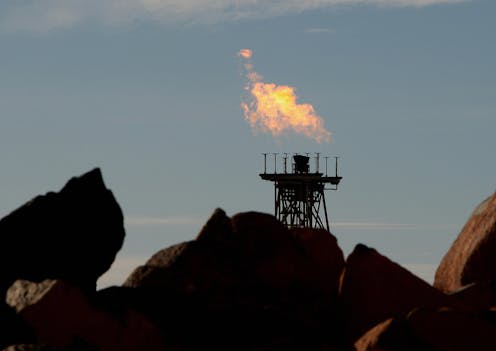Woodside’s North West Shelf approval is by no means a one-off. Here are 6 other giant gas projects to watch
- Written by The Conversation

The federal government’s decision to extend the life of Woodside’s North West Shelf gas plant in Western Australia has been condemned as a climate disaster.
The gas lobby claims more gas is needed to secure energy supplies, pointing to predicted gas shortages in parts of Australia in the short term. But given most proposed gas projects are directed at the export market, the problem is likely to persist.
And the science is clear: no fossil fuel projects can be opened if the world is to avoid catastrophic climate change.
Despite this, a slew of polluting gas projects are either poised to begin operating in Australia, or lie firmly in the sights of industry.
How Australia’s gas contributes to climate change
Gas production in Australia harms the climate in two ways.
The first is via “fugitive” emissions – leaks and unintentional releases that occur when gas is being extracted, processed and transported. These emissions are typically methane, which traps more heat in the atmosphere per molecule than carbon dioxide.
Fugitive emissions count towards Australia’s greenhouse gas accounts, comprising about 6% of our total emissions.
So, government approval for new gas projects undermines Australia’s commitment to reaching net-zero emissions. Labor enshrined this goal in legislation in its previous term of government, and all states and territories have also adopted it.
The second climate harm occurs when Australia’s gas is burned for energy overseas. Those emissions do not count towards our national emissions accounts, but they substantially contribute to global warming.
Under national environment law, the federal government is not required to consider the potential harm a project might cause to the global climate. This loophole means fossil fuel developments can continue to win government backing.
Below, I outline six of the biggest gas projects Australia has in the pipeline.
1. Barossa Gas Project
This A$5.6 billion project by energy giant Santos is located in the Timor Sea, about 300km north of Darwin. The Australian government’s offshore energy regulator approved it in April this year.
The project will extract gas from the Barossa field and transport it to a liquified natural gas (LNG) facility in Darwin for processing and export.
The venture would reportedly be among the worst polluting oil and gas projects in the world. On one estimate, it would release about 380 million tonnes of climate pollution over its 25-year life.
2. Scarborough Pluto Train 2
Pluto Train 2 is an extension of Woodside’s existing Scarborough project, centred around a gas field about 375km off WA’s Pilbara coast. A 430-kilometre pipeline would connect that gas to a second LNG train at a facility near Karratha. “Train” refers to the unit in a plant that turns natural gas into liquid.
The project has federal and state approval. It is about 80% complete and scheduled to begin operating by next year. According to Climate Analytics, the expansion would create about 9.2 million tonnes of carbon-dioxide equivalent each year.
3. Surat Phase 2
This coal seam gas project in Gladstone, Queensland, would be operated by Arrow energy – a joint venture between Shell and PetroChina.
It involves substantially expanding existing gas fields by building up to 450 new production wells. The project is expected to supply 130 million cubic feet of gas each day at its peak, and has been opposed by environment groups.
4. Narrabri Gas Project
This $3.6 billion Santos project in northwest New South Wales involves drilling up to 850 coal seam gas wells over 95,000 hectares. The National Native Title Tribunal last month ruled leases for the project could be granted, leaving Santos only a few regulatory barriers to clear.
Environmental groups and Traditional Owners say the project threatens water resources, biodiversity and Indigenous sites. However, the tribunal found the project’s benefits to energy reliability outweighed those concerns.
5. Beetaloo Basin
The Beetaloo Basin is located 500km southeast of Darwin. It covers 28,000 kilometres and is estimated to contain up to 500 trillion cubic feet of gas. A number of companies are vying for the right to develop the huge resource.
It is predicted to emit up to 1.2 billion tonnes over 25 years. A CSIRO report says Beetaloo could be tapped without adding to Australia’s net emissions. However, experts say the report was too optimistic and relies far too heavily on carbon offsets.
6. Browse Basin
Browse Basin, 425 kilometres north of Broome off WA, is considered Australia’s biggest reserve of untapped conventional gas.
Woodside plans to develop the Browse gas fields, but the area is remote and difficult to access. According to the ABC, Woodside’s North West Shelf project is considered the last hope for extracting the valuable resource.
Environmental groups say the project, if approved, would emit 1.6 billion tonnes of climate pollution – three times Australia’s current annual emissions.
The basin is also located near the pristine Scott Reef, a significant coral reef ecosystem.
A major disconnect
The projects listed above, if they proceed, weaken Australia’s efforts to reach its emission reduction goals. And their overall climate impact is truly frightening.
The re-elected Labor government has pledged to revisit attempts to reform national environment laws. This presents a prime opportunity to ensure the climate harms of fossil fuel projects are key to environmental decision making.







